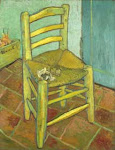
Just as 2010 marks an anniversary for Vincent van Gogh (the 120th anniversary of his death), it's also a key anniversary for my tied-for-#2 favorite artist, Michelangelo Merisi da Caravaggio (the other tied-for-#2 is Michelangelo Buonarroti). Caravaggio died 400 years ago this year, and the art world is predictably commemorating the occasion. Last month the famed Taschen publishing house released a brand-new catalogue raisonné of Caravaggio's work incorporating all the newest research (must get, must get...), and museum exhibitions have also been happening. The Art Institute of Chicago's show revolving around Caravaggio's "Supper at Emmaus" (normally at the National Gallery in London) has its last day today, and visitors to Rome can enjoy a Caravaggio-Francis Bacon dual exhibition (there's a combo to make your head spin) at the Galleria Borghese for another few weeks. The pièce de résistance, however, will be a show at the Scuderie del Quirinale in Rome opening February 20th and running through June 13th. This exhibition will bring together securely attributed Caravaggio paintings from throughout European and American collections into one place, including the two paintings 'rediscovered' in the 1990s: "The Taking of Christ," from the National Gallery of Ireland, and "Cardsharps" from the Kimbell Museum in Fort Worth. In my opinion, the organizers have been especially clever in focusing on paintings not in Roman museums/churches (with the exception of "David Holding the Head of Goliath" from the Galleria Borghese and "Deposition" from the Vatican), so that Caravaggio lovers can enjoy the exhibition, then traipse merrily to the churches and museums elsewhere in Rome that hold his work. Result: an overwhelming proportion of Caravaggio's oeuvre in the same city at the same time. Rapture!! Visit this website for a list of the paintings expected in the Scuderie show (in Italian) and some pictures, and the official website of the Scuderie del Quirinale for more information about the show and the venue.
Did I already mention that I LOVE Caravaggio? I'd never heard of him until spring 1989, when in the large auditorium hosting Art History 102, Emory's then-professor of Baroque art, Dr. Crelly, unleashed the painter's "Conversion of Saint Paul" (click image to enlarge) on the gathered students. I'd never seen anything like it. And the more Caravaggio paintings I've encountered, the more I've admired his dramatic use of light, his unconventional approach to very conventional religious subjects. And let's not forget his raucous personal life: Caravaggio has a likely deserved reputation as the bad boy of Baroque painting, working hard in his studio by day, prowling the backstreets of Rome with a sword on his hip and a gang of friends by his side at night. He used prostitutes as companions and models, got arrested more than once for incidents involving his legendary bad temper, and finally had to flee Rome to four years in exile after accidentally killing a man during a fight over a tennis match. Everyone wonders how such a "sinner" can create such sublime religious images -- but perhaps a sinner like that understands more than anyone the struggles and fears that actually underlie many of the stories. Not for Caravaggio the often-saccharine smiling figures of many Baroque altarpieces: his Christ, his saints, his Virgin Mary are REAL. So real that it sometimes got him into trouble. The first version of his "Saint Matthew and the Angel," for instance, intended for the Contarelli Chapel of the church of S. Luigi dei Francesi in Rome, was rejected by the patron because Caravaggio showed the saint with a laborer's tunic and dirty feet. The second, more decorous version hangs in the church today.
Caravaggio died in a small town on the coast of Italy of probably yellow fever, although the circumstances of his death remain murky. He was on his way back to Rome seeking a formal pardon for the accusation of murder, having spent time down south in Naples, Sicily, and Malta. He was almost thirty-nine years old. The face of Goliath in his alleged last painting, "David with the Head of Goliath," is said to be his own.






-Vincent-van-Gogh-Met.jpg)
